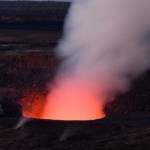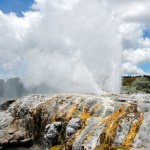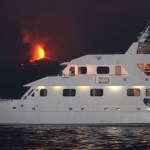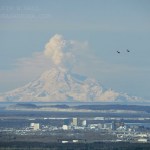united states
The Halema'uma'u Crater at Kilauea on June 29, 2009, prior to a rockfall on June 30th that has blocked the vent. Image courtesy of HVO.
There is a bit of a buzz today about significant rockfalls that occurred in Halema'uma'u Crater at Kilauea on June 30th. Some articles have suggested that the rockfall has "snuffed out" glowing vent in the Crater. Well, this is partially true. HVO is reporting that the glow that has been seen at Halema`uma`uma has been, in fact, gone since the rockfall. Here is the report of the event:
A sequence of rockfalls, some quite large, within the Halema'uma'u vent…
Redoubt steaming in early 2009. Image courtesy of Calvin Hall.
It has been a while since we spoke of Redoubt, but now it seems the reason why might be that the eruption is ending. AVO lowered the Alert Level at Redoubt to Yellow from Orange, indicating that they believe the volcano is less likely to have a large eruption. This doesn't mean that it is out of the question, but rather that signs seem to be pointing to the idea that the eruption is waning.
AVO sums the change:
Seismic, satellite, gas, and deformation observations over the past few weeks indicate that growth of the lava dome at…
A few quick news bits ... and thanks for the questions so far. Keep 'em coming!
Tungurahua, Ecuador erupting in 2006.
Ash fall from Tungurahua (in spanish) in Ecuador is affecting the farm towns around the volcano. Farmers in Manzano, a village nearby, fear the ash is significant enough to damage their crops. The volcano itself is throwing incandescent bombs near the vent along with producing copious ash.
There is a nice piece in the News Tribune about how Alaska Airlines handled the eruption of Mt. Redoubt near Anchorage this March. It is nice to get some insight into how airlines deal with…
Your weekly dose of volcano news brought you by the Smithsonian Institute GVP and the USGS.
This week's highlights (not counting Sarychev Peak and Turrialba) include:
13,000 foot / 4 km ash plumes from Rinjani in Indonesia. This is part of the continuing eruption there.
The alert level was lowered at Galeras, Colombia to "Orange" after intense eruptions last week.
The current lava dome at Redoubt is 1 km long, 460 m wide, and 200 m high according to the latest images from the Alaskan volcano.
18,000-23,000 foot / 4.8-7.7 km ash plumes from Shiveluch in Kamchatka, along with thermal anomalies…
Mt. Saint Helens in Washington state, USA
I'm back from my sojourn to New England and its time to play catch up. First things first!
There has been a lot of chatter in my inbox and on the comments here at Eruptions about the study/press release from Graham Hill's research group talking about the potential for a supervolcano forming at Mt. Saint Helens. This study (presented at the AGU Spring Meeting) was based on a magnetotelluric study of the area around (and below) Saint Helens. For those of you unfamiliar with magnetotellurics, it uses instruments that measure the magnetism and electrical…
You'll have to excuse the curtness of this post. An bad hop in softball will do that to you.
Here's some news:Mt. Dempo in Indonesia
Xinhua offers some nice pictures of the current activity going on at the summit crater at Nyiragongo in the Congo. Note the partially-crusted-over lava lake in the first shot. The Red Cross is updating the evacuation and mitigation plans for the area as the volcano shows increased activity.
The alert level at Mt. Dempo in Indonesia was raised to the second highest level. There has been ash fall (as far as 10 km from the vent) and volcanic gas emissions. The…
Pohutu Geyser in Rotorua, New Zealand. Image taken by Erik Klemetti in January 2009.
It has been busy busy week for me, capped off today with a talk about my field work in New Zealand (see above), so I don't have much to say. Not much new news today about the Saudi Arabian earthquake swarms, but again, I'll keep my eyes pealed (incidentally, I still haven't been able to figure out why no western news sources have even mentioned the swarm).
Anyway, here's are some volcanic tidbits to enjoy over the long weekend:
Vog, as seen from space. Volcanic fog, fashionably shortened to "vog" is a real…
A week's worth of volcano news in one sitting, thanks to the USGS and Smithsonian Inst.'s Global Volcanism Program.
Thanks again, Sally Kuhn Sennert for putting it together!
This week's highlights include:
Small ash column spotted at Manam, Papua New Guinea. We talked about Manam not too long ago.
More details of the ongoing submarine eruption at West Mata in the Mariana Islands.
The lava dome continues to grow on Redoubt, Alaska with no real collapse yet.
Pilots spotted small (2.1 km / 7,000 foot) steam/ash plumes at Suwanosejima, Japan.
5-6 km / 18-25,000 foot ash plumes were produced by…
Mauna Kea from space taken April 2009. Image courtesy of the NASA EO.
Just a quick link to a stunning photo of Mauna Kea in Hawai'i taken April 29, 2009 from the International Space Station. You can clearly see the pyroclastic material and abundant cinder cones that litter the flanks of the volcano.
{Thanks to the NASA Earth Observatory for the image link.}
Mount Saint Helens less than 30 seconds after a sector collapse that triggered one of the largest eruptions in the Cascades in the last 500 years.
Today is the 29th anniversary of the dramatic eruption of Mount Saint Helens in Washington state. The eruption dramatically changed the landscape around the volcano along with greatly increasing our understanding of volcanic sector collapses and explosive eruptions. I was going to write a larger entry on the event, but alas, I will instead be lecturing to 100 UC Davis students about the event today instead (sorry folks!)
Instead, if you want to…
Fernandina in the Galapagos erupting in April 2009. Photo by Harald Schmidt
First off, I wanted to thank everyone who has submitted volcanoes images so far. They are an remarkable collection (see examples above and below) that I will start using with the articles as they fit. Thank you for sharing these images and your experiences with me (and eventually, with the readers of Eruptions).
That being said, send me (more) pictures of volcanoes - erupting or not - that I might use on the blog. I will be sure to give you appropriate credit for the image and if you'd like me to link to your…
Things are busy - both volcanically and personally - so I'm going to just give you some links to a bunch of exciting/interesting/insane news:
West Mata erupting on May 5, 2009 in the Lau Basin.
According to a bunch of news sources, the eruption at Fernandina in the Galapagos is over (in spanish). That being said, the PNG noted that there is still a lot of carbon dioxide and sulfur dioxide being emitted, suggesting there is still a lot of degassing magma beneath the vents - at what depth (and will it erupt) is the question.
There is a lot of speculation that Nyiragongo (DRC) is erupting or…
The Geysers Geothermal Power Plant
Eruptions reader (and former hallmate at Oregon State) Ed Kohut sent me a message today pointing out that there is an ongoing earthquake swarm in the area of the Geysers in northern California. Now, I don't know what the normal seismicity is underneath the Clear Lake area and this area is part of the San Andreas fault system, so these earthquake are likely not volcanically related, but I post them here just as a reminder of how difficult it can be to deconvolve these geologic signals.
The Geysers are part of the Clear Lake volcanic region, which is still…
Some brief tidbits from the volcanic realms:
Active volcanism at NW Rota-1
Kilauea? Explosive? You might think of Kilauea as a volcano that generates impressive Hawaiian-style eruptions with fire fountains reaching 100s m and dazzling lava flows, but Don Swanson at HVO sees evidence of a big explosive event at Kilauea. This eruption was ~1,000-1,600 years ago and may have produced a plinian-scale eruptive column and threw cm-scale chunks up to 17 km from the vent.
The intermingling of life and active volcanism always seems counterintuitive, but when you're talking undersea volcanism, all…
The clock is ticking for the new dome growing at Redoubt to collapse. What will happen if/when it does collapse? Good question!
The new dome at Redoubt. Image courtesy of AVO/USGS, taken by Game McGimsey, April 30, 2009.
Most likely, the following will occur:
First, extrusion of lava will cause the dome to over-steepen, precipitating the collapse (although a large seismic event could also trigger collapse as well). An excellent example of this is the spine that grew at Mont Pelee on Martinique in 1902 before the famous eruption that destroyed St. Pierre and killed >30,000 people.
When it…
For those of you who might not be paying as close attention to Redoubt now as in the past, this is the latest from AVO:
Redoubt's 2009 eruption continues and appears to be gaining intensity. Seismic activity has increased markedly in the last 24 hours, showing stronger volcanic tremor and more frequent rockfall events. Minor emissions of ash have also been visible in webcam views during this time period. Steam emissions in particular have become more vigorous over the last 2 hours, with a steam plume now reaching approximately 18,000 feet above sea level.
Are we headed to a dome collapse in…
Redoubt in April 2009 with Anchorage in the foreground (along with two F-22 Raptors). Image courtesy of Calvin Hall.
It has been quite some time since I talked about Redoubt, mostly because the volcano has been in the "slow extrusion of a dome" mode that has not generated much beyond impressive steam (with some ash) plumes. The volcano continues to stay at Orange/Watch status. I did glean a few interesting facts and speculations about the future at Redoubt from Dr. Jake Lowenstern of the USGS the other day, including:
The new dome growing on the volcano has more room to expand than the 1989-…
Volcano monitoring. Image courtesy of the USGS.
Last night I had the opportunity to see a talk given by YVO Scientist-in-Charge Dr. Jake Lowenstern as part of the Volcanological Society of Sacramento meeting and he gave a great talk on the state of volcano monitoring today in the U.S. He laid out a lot of details concerning the Volcano Hazards Program of the USGS and I thought I'd share some of them so we can all have an idea of the ups and downs of the VHP these days.
First off, nothing says fun like the U.S. Volcano Status Map! Apparently the dreaded watch "eye" was not meant to be a…
The weekly USGS/SI roundup is out. Highlights (beyond Slamet) include:
Explosions (some heard 25 km away) and incandescent blocks that started fires at Galeras, Colombia.
Ash and tephra being thrown tens of meters into the air and a 4-m tall spatter cone being built at Pacaya, Guatemala
Also in Guatemala, Santa Maria's Santiaguito dome produced ash plumes and explosions.
Steam, ash and sulfur odors from the continuing eruption at Redoubt, Alaska.
Increased seismicity, steam and ash plumes along with a thermal anomaly at El Reventador in Ecuador
The latest numbers of confirmed cases from the CDC were released about an hour ago. 91 cases have been confirmed, with the largest numbers in New York (51), California (14), and Texas (16). One new case has also been confirmed in Nevada, one in Indiana, one in Arizona, and 2 in Michigan; the other Ohio case I know of is still pending, apparently. Ongoing investigations are also taking place in multiple states, so expect the number to keep rising for the time being. [Update: 2 cases just confirmed in Massachussets, and three in Maine.]
The first fatality has also been reported: a 23-month-…




